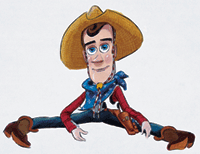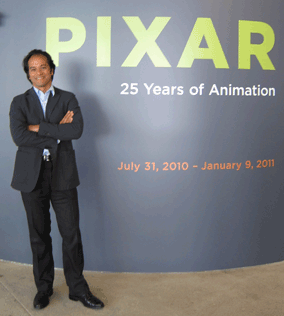25 Years of Pixar: Take BART to exhibit exploring history of pioneering animators
 |
| Bud Luckey, Woody, Toy Story, 1995. Mixed Media. ©Disney/Pixar |
By Xuan Lam
BART Website Intern
Pixar has a reputation for always upping the ante. A new exhibit at the Oakland Museum of California takes visitors on a tour of the Emeryville animation pioneer’s 25-year history, showing how it has created some of the most beloved stories in contemporary cinema.
From unforgettable characters to endearing stories to immersive worlds, Pixar has a knack for keeping audiences awestruck with its technological wizardry, while simultaneously tugging at moviegoers’ hearts with the power of emotions.
"Pixar artists are inspired by the narratives," says Paul Topolos, a Pixar artist whose works from films such as Ratatouille and Wall-E are part of the exhibition. "We fall in love with the story because it comes from emotions and thinking about our own experiences. It’s a collaborative environment to tell a good story. And nothing get in the way of that."
"Pixar: 25 Years of Animation," opens July 31 and runs through January 9, 2011, at the Oakland Museum of California, just steps away from the Lake Merritt BART Station. It comes to the Bay Area after a popular international tour, which was prompted when New York’s Modern Museum of Art approached the company in 2005.
The exhibition features more than 500 artifacts -- including drawings, paintings, sketches sculptures, and maquettes -- from 11 of Pixar’s feature films and some of its short films. It also features storyboards and colorscripts, narrative tools used by artists that illustrate the story scene-by-scene. In addition, some of the works are displayed through two interactive, state-of-the-art media installations – Artscape and the Pixar Zoetrope.
"What makes Pixar so special is their creative culture," says Rene de Guzman, senior curator of art at the museum. "The show is about drawing attention to the creative individuals within the Pixar company. They’re pushing technology and storytelling at the same time."
The Pixar showcase fills 11,000 square feet of temporary exhibition galleries and expands into common spaces such as hallways and the museum store. It includes video projections, interactive kiosks and mural-size graphics. The exhibition highlights the relationship between Pixar’s storytelling and the innovation of the Bay Area’s technology scene.
 |
|
Curator Rene de Guzman/Photo by Xuan Lam |
Both Topolos and Guzman note that the Bay Area has a synergy of artistic creativity from filmmakers such as Francis Ford Coppola and technological achievements from innovators such as Steve Jobs.
On a recent preview tour, I discovered how this exhibit will stick with visitors long after their trip to the museum. As a moviegoer simply seeking entertainment, it’s easy to miss the fine details of the fish whizzing by in Finding Nemo, the myriad of exotic plants in the jungles of Up, or the technological intricacy of Wall-E. Walking through the exhibit, you become so immersed in these worlds that you see details you might have missed on the screen.
The exhibit is divided into three segments: Story, Character, and World.
Character: This segment begins with Luxo Jr., the iconic lamp character that has embodied Pixar from its start in the 1980s. An original model of Luxo Jr. was the first thing to greet me as I walked into the exhibition. As I continued along, I witnessed dozens of renderings of just one character. I saw the character of Edna come to life through the progression of artists’ ideas. I looked with reverence at the meticulously sculpted figures, not a single flaw on any of them. I thought to myself, "Where would Toy Story be without Woody and Buzz Lightyear? Would we ever have found Nemo without the help of Dora?"
Story: Arguably the most important part of any movie, stories are given painstaking attention by Pixar artists. And it clearly shows through their work in the exhibit. One of the first pieces to catch my eye was a huge, digitally made storyboard -- full of life and color. Storyboards are a succession of scenes illustrating each significant event in the scene or entire film. They can be digitally made, painted, sketched, or drawn. I slowly made my way to each storyboard, relishing and reminiscing the scenes I cherished as a child. Scenes from The Incredibles, Wall-E, and Toy Story flashed by one after the other. Adding another element to the idea of story, this section also features a device that recalls the early days of cinema. A huge, three-dimensional Zoetrope shows a rapid succession of images and creates the illusion of motion.
World: The most expansive section of the exhibition shows the multitude of "worlds" Pixar has created through beautiful drawings, sketches, and models. Immersive is an understatement. The Artscape installation, for example, is a wide-screened projection of digitally made images that allow audiences to feel like they’re literally in the artwork. The setup is as stimulating as a 3D movie but without the annoying, bulky glasses and the pangs of nausea and fatigue afterwards. From the elaborate sounds to the intricate details of the artwork, Artscape provides a whole new level of audience interaction. The beautiful figurines of wildlife created by Bryn Imagire for the movie Up are another prime example. Vibrant and detailed, the eye-catching gems lure you into a world of adventure and imagination. Peering into these different worlds, it would be easy to forget that they’re fictional. Buzz Lightyear’s mantra "to infinity and beyond" never seemed so relevant.
The museum advises visitors to buy tickets online in advance. For more information visit the museum website. It’s easy to get to the museum on BART. Just get off at Lake Merritt Station and head toward Oak Street. Plan your trip using the BART QuickPlanner.
To see a photo gallery with more images from the exhibit, visit the SFBART blog.
Xuan Lam is a BART website intern who will be attending Smith College in the fall. You can contact her at [email protected]